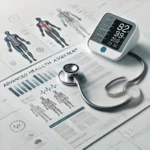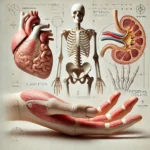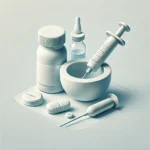Table of Contents
ToggleIntroduction: Why Mastering Pharmacology is Crucial for Nursing Students
Pharmacology is one of the most essential subjects in nursing education. As a nursing student, your ability to understand how medications work, their intended effects, and their potential side effects directly impacts patient outcomes. Nurses are often the last line of defense in medication administration, responsible for verifying dosages, recognizing contraindications, and educating patients about their prescriptions.
Mastering pharmacology is not just about passing exams—it’s about ensuring the safety and well-being of your future patients. A strong grasp of pharmacology allows you to:
- Administer medications accurately and safely.
- Anticipate potential side effects or adverse reactions.
- Educate patients about how and when to take their medications.
- Collaborate effectively with other healthcare professionals by understanding the pharmacological principles behind treatment plans.
As challenging as pharmacology may seem, approaching it with the right strategies and mindset can turn it into an empowering subject that enhances your confidence in clinical practice. By investing time and effort into mastering pharmacology, you’re not only preparing for success in nursing school but also laying the foundation for a rewarding career in healthcare.
In the following sections, you’ll discover actionable strategies to make pharmacology more manageable and even enjoyable. Let’s get started!
Step 1: Understanding Drug Classifications: The Foundation of Pharmacology
One of the best ways to approach pharmacology is to start with drug classifications. Medications are grouped into categories based on their therapeutic effects, mechanisms of action, or chemical structure. Understanding these classifications provides a solid framework for studying pharmacology because it helps you identify patterns and similarities among drugs, making them easier to remember and apply in clinical practice.
For example:
- Antibiotics are categorized into classes like penicillins, cephalosporins, and macrolides. Each class shares similar mechanisms of action and potential side effects.
- Antihypertensives, such as ACE inhibitors, beta-blockers, and calcium channel blockers, can be grouped by how they lower blood pressure, simplifying your learning process.
Why Drug Classifications Make Studying Easier
- Recognizing Patterns:
Instead of memorizing every individual drug, focus on understanding the common characteristics of the class. For instance, all beta-blockers typically end in “-lol” (e.g., metoprolol, atenolol) and work by reducing heart rate and blood pressure. - Building Connections:
Grouping drugs helps you see how they relate to each other. For example, knowing that opioids like morphine and fentanyl work on the same receptors can help you understand their similar effects and side effects. - Streamlining Study Time:
By focusing on classifications, you reduce the need to memorize long lists of unrelated drugs. Mastering one class equips you with the knowledge to understand several individual medications.
How to Learn Drug Classifications
- Start with the basics: Focus on the most common drug classes you’ll encounter in nursing school and clinicals, such as analgesics, anticoagulants, and diuretics.
- Use visual aids: Create charts or tables that compare drug classes, their mechanisms of action, and major side effects.
- Leverage mnemonics: Develop memory aids to recall key drug classes and their characteristics. For example, for beta-blockers: “Beta blockers love the heart but hate asthma” (to remember they affect heart rate but may cause bronchoconstriction).
Step 2: The Power of Mnemonics: Making Medication Details Stick
Mnemonics are powerful tools to simplify complex information, making it easier to remember drug names, side effects, and mechanisms of action. By turning dry details into memorable phrases or acronyms, mnemonics transform studying into a more engaging and effective process.
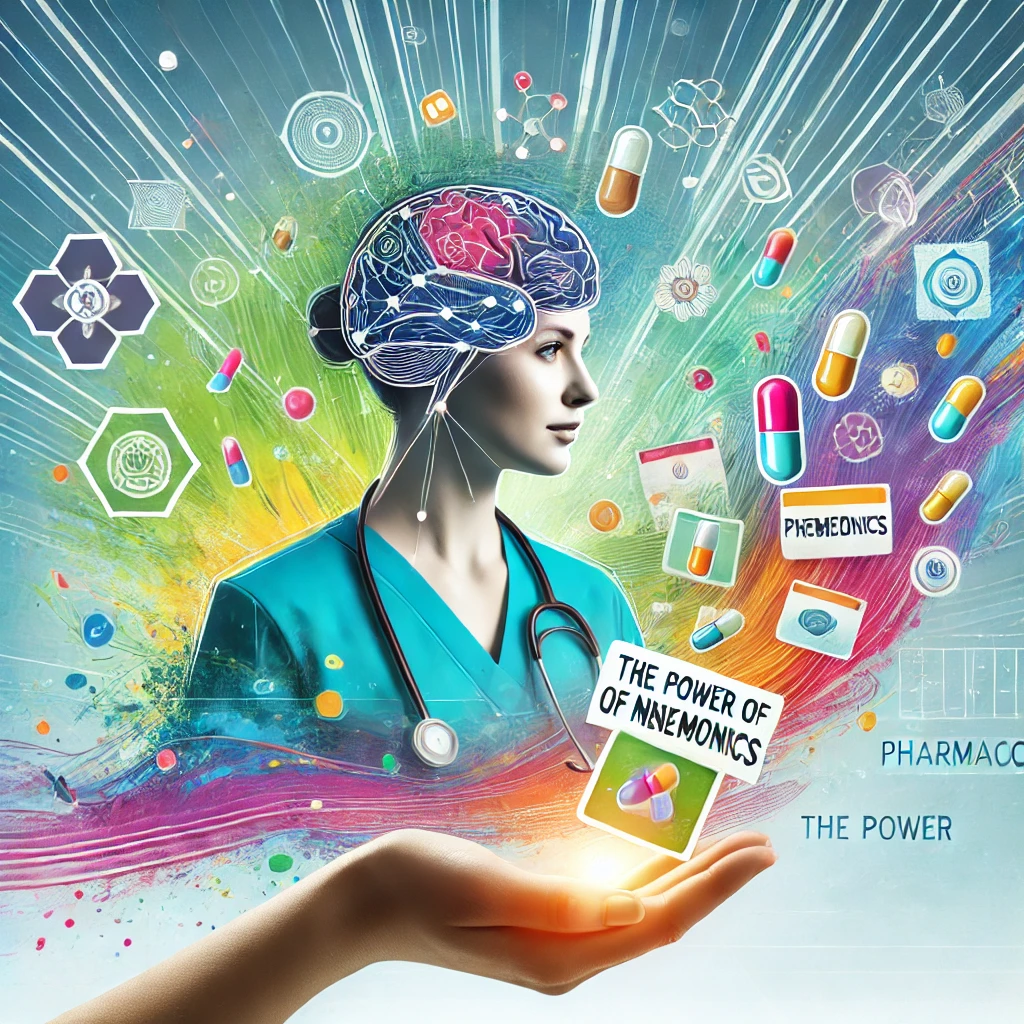
Mnemonics for Drug Names
Learning drug names can be challenging, but mnemonics can help you recognize patterns within drug classes.
- Beta-Blockers (end in -lol):
- Mnemonic: “Beta blockers love the heart.”
- Example: Propranolol, Atenolol, Metoprolol
- ACE Inhibitors (end in -pril):
- Mnemonic: “ACE the test by April.”
- Example: Lisinopril, Enalapril
- Calcium Channel Blockers (end in -pine):
- Mnemonic: “Calcium helps the spine.”
- Example: Amlodipine, Nifedipine
Mnemonics for Drug Side Effects
Remembering side effects is crucial for safe medication administration.
- ACE Inhibitors:
- Mnemonic: “ACE—Angioedema, Cough, Electrolyte imbalance.”
- Anticholinergic Side Effects:
- Mnemonic: “Can’t see, can’t pee, can’t spit, can’t sh—.”
- Helps recall dry eyes, urinary retention, dry mouth, and constipation.
- Loop Diuretics (e.g., Furosemide):
- Mnemonic: “Loops lose everything.”
- Recall they cause loss of potassium, sodium, and water
Mnemonics for Mechanisms of Action
Understanding how drugs work helps connect their effects to patient care.
- Opioids:
- Mnemonic: “O for Opioids, O for On receptors.”
- Opioids work by binding to opioid receptors to block pain.
- Beta-Blockers:
- Mnemonic: “B for Beta, B for Beat slower.”
- Beta-blockers reduce heart rate and blood pressure.
- Anticoagulants (e.g., Warfarin):
- Mnemonic: “WAR on clots.”
- Warfarin works by interfering with vitamin K to prevent clot formation.
Creating Your Own Mnemonics
If you struggle with specific medications, create personalized mnemonics that are meaningful to you. For example:
- For insulin types, you could use “LAG” for Lispro, Aspart, and Glulisine, which are rapid-acting insulins.
- For remembering that nitrates help “NO” angina pain, think of Nitroglycerin and NO (Nitric Oxide).
Tips for Using Mnemonics Effectively
- Write down mnemonics on flashcards for frequent review.
- Pair mnemonics with visuals to create a stronger memory association.
- Share mnemonics with study groups to reinforce learning collaboratively.
Very Well Health has provided a complete guide on how to use mnemoics which we recommend you to read and learn to improve you memory.
Step 3: Flashcards: Your Best Friend for Memorizing Medications
Flashcards are one of the most effective tools for nursing students to learn pharmacology. They are portable, customizable, and perfect for active recall—a proven method for improving memory. Whether you use physical cards or digital apps, flashcards allow you to break down complex pharmacology concepts into bite-sized, manageable chunks.
Here’s how to create and use flashcards effectively to boost your pharmacology knowledge:
1. Organize Your Flashcards by Drug Class
Group flashcards by drug categories, such as antibiotics, antihypertensives, or diuretics. This helps you see patterns and makes it easier to learn related medications together.
For example:
- Front: “Beta-blockers”
- Back: “End in -lol, reduce heart rate and blood pressure, common drugs: metoprolol, propranolol.”
2. Include Key Information on Each Card
Each flashcard should be concise but include critical details:
- Drug Name: Generic and brand names.
- Class: The drug category it belongs to.
- Mechanism of Action: A short description of how it works.
- Uses: Common conditions it treats.
- Side Effects: High-yield or frequently tested adverse effects.
Example:
- Front: “Lisinopril”
- Back: “ACE inhibitor; reduces blood pressure by blocking angiotensin-converting enzyme. Common side effects: dry cough, angioedema.”
3. Use Visual Aids for Better Retention
Add simple drawings, color coding, or symbols to enhance memory. For instance:
- Highlight side effects in red to indicate caution.
- Use green to signify therapeutic effects.
- Draw a kidney for diuretics to remind you they act on the renal system.
4. Test Yourself with Active Recall
Flashcards are most effective when you actively test yourself. Look at the front of the card and try to recall the details on the back without flipping it over. This technique strengthens neural connections and improves long-term retention.
5. Incorporate Spaced Repetition
Review your flashcards in intervals. Start with frequent reviews (e.g., daily), then space them out (e.g., weekly) as you master the material. Apps like Anki or Quizlet can automate spaced repetition for digital flashcards.
6. Use Flashcards for Clinical Scenarios
Create scenario-based flashcards to apply your knowledge.
- Front: “Patient with chest pain, blood pressure 150/90. Drug of choice?”
- Back: “Nitroglycerin; relaxes blood vessels, reduces workload on the heart.”
This approach helps bridge the gap between theoretical knowledge and clinical application.
7. Quiz with Peers
Share your flashcards with classmates or use them in study groups. Taking turns quizzing each other can uncover gaps in understanding and reinforce learning.
8. Keep Updating and Refining
Pharmacology is vast, so keep adding new drugs or details as you encounter them in class or clinicals. Regular updates ensure your flashcards stay relevant.
Step 4: Mechanisms of Action: Focus on Understanding, Not Just Memorizing
One of the most effective ways to master pharmacology is to shift your focus from rote memorization to understanding how drugs work in the body—their mechanisms of action. This approach not only helps you retain information better but also equips you to apply your knowledge in clinical settings.
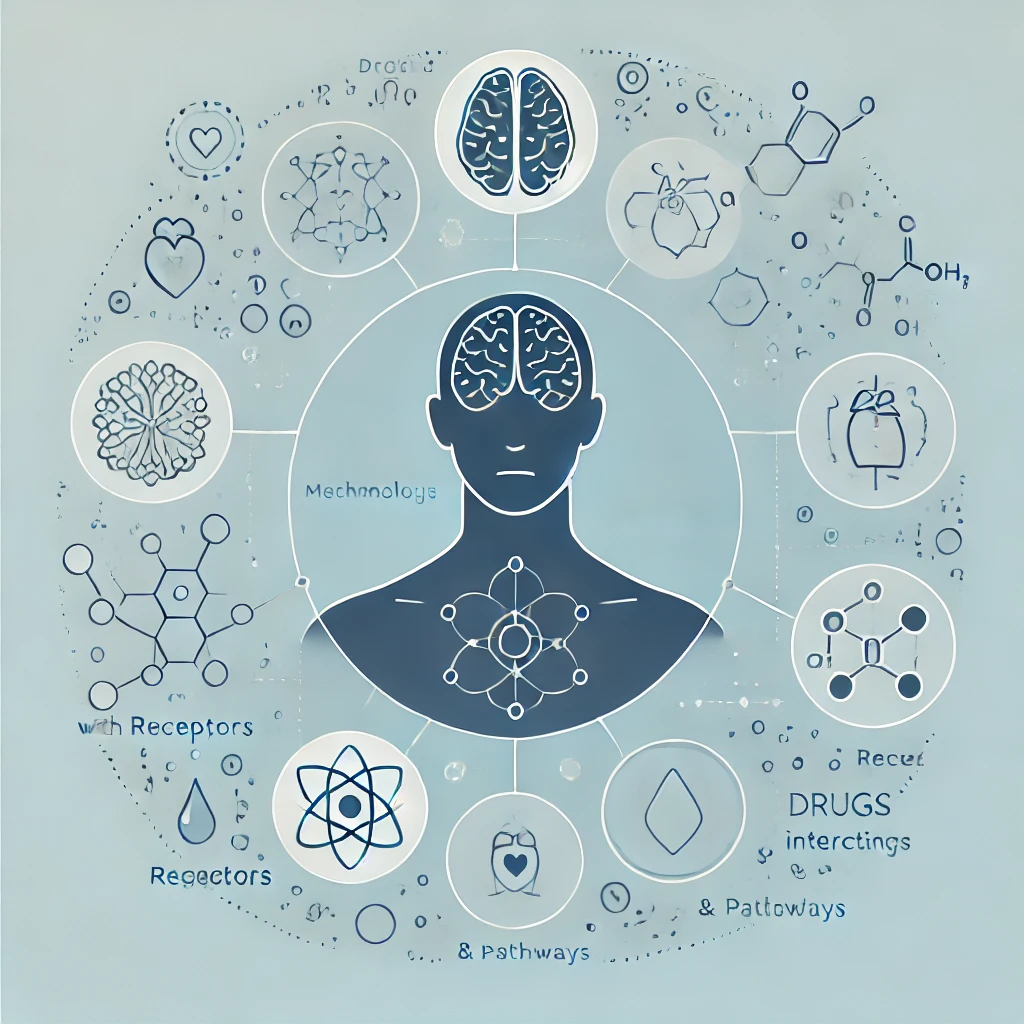
What Are Mechanisms of Action?
The mechanism of action (MOA) explains how a drug produces its therapeutic effects in the body. It involves understanding the drug’s interaction with cells, tissues, or organs and how this leads to the desired physiological outcome.
For example:
- Beta-blockers: Work by blocking beta-adrenergic receptors, reducing heart rate and blood pressure.
- Insulin: Facilitates glucose uptake into cells, lowering blood sugar levels.
Why Understanding MOA Matters
- Improves Retention
When you understand how a drug works, it’s easier to connect it to its effects, uses, and side effects. For instance, knowing that diuretics increase urine output makes it logical to associate them with dehydration as a potential side effect. - Supports Clinical Application
Understanding MOA allows you to anticipate how a drug will behave in specific clinical scenarios. For example, knowing that anticoagulants inhibit clot formation helps you understand their use in preventing strokes or deep vein thrombosis (DVT). - Facilitates Critical Thinking
Instead of memorizing drug names and uses, understanding MOA helps you think critically about which drugs are appropriate in certain conditions or how to manage adverse effects.
How to Study Mechanisms of Action
- Start with the Basics
Focus on high-yield drugs that are commonly used in clinical practice. For example:
- Antibiotics: Understand how they target bacteria (e.g., penicillins inhibit cell wall synthesis).
- Antihypertensives: Learn how they lower blood pressure (e.g., ACE inhibitors block angiotensin-converting enzyme).
- Use Visual Aids
Diagrams, flowcharts, and animations can help you visualize how a drug interacts with the body. For example, watching a video on how insulin facilitates glucose transport can make the concept clearer. - Relate MOA to Side Effects
Many side effects arise from a drug’s mechanism of action. For instance:
- NSAIDs: Inhibit prostaglandin synthesis, which reduces inflammation but can also cause stomach ulcers.
- Beta-blockers: Slow heart rate but may cause fatigue or bronchospasm due to their effects on the respiratory system.
- Connect MOA to Therapeutic Uses
Think about why a drug is used in a particular condition based on its MOA. For example: - Calcium channel blockers: Relax blood vessels, making them useful for treating hypertension and angina.
- Practice with Clinical Scenarios
Apply your understanding of MOA to case studies or test questions. For example: - Scenario: A patient with asthma and high blood pressure needs an antihypertensive. Why might you avoid beta-blockers? (Answer: They can cause bronchospasm.)
Examples of Simplified MOA
- Loop Diuretics (e.g., Furosemide): Block sodium and chloride reabsorption in the loop of Henle, leading to increased urine output.
- Proton Pump Inhibitors (e.g., Omeprazole): Inhibit proton pumps in the stomach lining, reducing acid production.
- SSRIs (e.g., Fluoxetine): Increase serotonin levels in the brain by inhibiting its reuptake, improving mood.
Tips for Mastering MOA
- Ask Why: Always question why a drug works the way it does. This deepens your understanding.
- Teach Others: Explaining MOA to a peer or study group reinforces your knowledge.
- Combine Resources: Use textbooks, videos, and practice questions to explore MOA from different angles.
Step 5: Test Banks: A Must-Have Resource for Practice
Pharmacology test banks are an invaluable resource for nursing students aiming to master medication-related content and excel in their exams. These collections of NCLEX-style questions are designed to mimic the challenges you’ll face in nursing school tests and on the NCLEX, helping you strengthen your understanding of pharmacology concepts while building confidence in your test-taking skills.
Here’s why incorporating test banks into your study routine is a game-changer:
1. Familiarize Yourself with NCLEX-Style Questions
Pharmacology test banks provide a variety of question formats, including multiple-choice, select-all-that-apply (SATA), and scenario-based questions. These formats are similar to what you’ll encounter in exams, helping you become comfortable with the structure and wording of NCLEX questions.
- Example:
Question: A patient is prescribed lisinopril. What potential side effect should the nurse monitor for?- A) Cough
- B) Weight gain
- C) Hyperkalemia
- D) Hypoglycemia
(Correct Answers: A, C)
Checkout our NCLEX resources.
2. Strengthen Clinical Application Skills
Test banks focus on real-world scenarios, requiring you to apply theoretical knowledge to practical situations. For example, understanding the mechanism of action of a drug isn’t enough—you’ll need to know how it’s used in specific patient cases and what potential adverse effects to anticipate.
- Scenario-Based Question:
A patient with chronic kidney disease is prescribed a diuretic. Which medication would the nurse question?
(Correct Answer: Furosemide, due to potential electrolyte imbalance in renal impairment.)
3. Identify Knowledge Gaps
Regularly practicing with test banks helps pinpoint areas where you’re struggling. By reviewing your incorrect answers, you can focus your study efforts on weak topics, such as specific drug classes, side effects, or nursing considerations.
4. Reinforce Active Recall and Critical Thinking
Test banks force you to actively recall information rather than passively rereading notes. This strengthens memory retention and enhances your ability to think critically under pressure—a vital skill for both exams and clinical practice.
5. Practice Time Management for Exams
Test banks simulate timed exams, helping you practice managing your time effectively. This ensures you can complete your tests without feeling rushed or stressed.
6. Learn Rationales for Correct and Incorrect Answers
High-quality test banks include detailed explanations for both correct and incorrect options. These rationales deepen your understanding of why certain answers are right and others are wrong, reinforcing key pharmacology concepts.
- Example Rationale:
Lisinopril can cause a dry cough due to increased bradykinin levels. Hyperkalemia is a risk because ACE inhibitors decrease potassium excretion.
Tips for Using Test Banks Effectively
- Start Early: Begin incorporating test bank questions into your study routine as soon as you start learning pharmacology.
- Review Rationales Thoroughly: Don’t just focus on correct answers; understanding the reasoning behind all options is key.
- Mix Topics: Use test banks to review a variety of drug classes and scenarios to strengthen your overall pharmacology knowledge.
- Track Your Progress: Note patterns in your mistakes and revisit those areas to reinforce your understanding.
- Use Reputable Sources: Ensure you’re using test banks from trusted providers that align with NCLEX standards.
For more details you can read our blog on how to maximize study efficiency with test banks.
Step 6: High-Yield Drugs: Prioritize What Matters Most
High-yield drugs are the ones most commonly used in clinical practice, frequently tested in nursing school, and crucial for patient care. By focusing on these medications, you can build a strong foundation and manage your study time effectively.
What Are High-Yield Drugs?
High-yield drugs are those that:
- Appear frequently on exams, including the NCLEX.
- Are commonly encountered in clinical settings.
- Serve as prototypes for their drug class, representing key mechanisms and effects.
Examples include:
- Antibiotics: Amoxicillin, Ceftriaxone, Azithromycin.
- Antihypertensives: Lisinopril, Metoprolol, Amlodipine.
- Anticoagulants: Warfarin, Heparin, Enoxaparin.
- Diuretics: Furosemide, Hydrochlorothiazide, Spironolactone.
- Pain Management: Acetaminophen, Morphine, Ibuprofen.
Why Focusing on High-Yield Drugs Works
- Maximizes Study Efficiency
Concentrating on high-yield drugs allows you to cover the most critical content first. These medications often serve as a blueprint for understanding other drugs in the same class. - Builds a Strong Knowledge Base
Learning key drugs helps you grasp the broader principles of pharmacology, such as drug mechanisms, therapeutic uses, and side effects. - Boosts Exam Performance
High-yield drugs are more likely to appear in exam questions, making your focused study time directly relevant to your success. - Prepares You for Clinical Practice
By mastering the medications you’ll encounter most often in patient care, you’ll feel more confident and competent during clinical rotations.
How to Identify High-Yield Drugs
- Review Your Course Material: Pay attention to drugs highlighted in lectures, textbooks, and study guides.
- Use NCLEX Blueprints: Focus on drugs and conditions emphasized in NCLEX practice materials.
- Ask Instructors or Peers: Seek guidance from instructors or upperclassmen on which drugs are most commonly tested.
- Leverage Test Banks: Practice questions often highlight frequently tested medications.
Strategies for Studying High-Yield Drugs
- Master the Prototypes:
For each drug class, identify and study the prototype drug (e.g., Lisinopril for ACE inhibitors, Furosemide for loop diuretics). Once you understand the prototype, you can generalize its characteristics to other drugs in the same class. - Use the 5 Key Points Method:
For each high-yield drug, focus on these five critical aspects:
- Class and mechanism of action.
- Indications (what it’s used for).
- Common side effects.
- Major contraindications or warnings.
- Nursing considerations (e.g., monitoring, patient education).
- Incorporate Spaced Repetition:
Regularly review high-yield drugs to reinforce your memory and ensure long-term retention. - Apply to Clinical Scenarios:
Practice integrating high-yield drugs into patient case studies to improve critical thinking and application skills.
Examples of High-Yield Drug Insights
- Lisinopril (ACE Inhibitor):
- MOA: Blocks angiotensin-converting enzyme, lowering blood pressure.
- Uses: Hypertension, heart failure.
- Side Effects: Dry cough, hyperkalemia, angioedema.
- Furosemide (Loop Diuretic):
- MOA: Blocks sodium and chloride reabsorption in the loop of Henle.
- Uses: Edema, heart failure.
- Side Effects: Hypokalemia, dehydration, hypotension.
- Warfarin (Anticoagulant):
- MOA: Inhibits vitamin K-dependent clotting factors.
- Uses: Prevents clot formation in atrial fibrillation or DVT.
- Side Effects: Bleeding, requires INR monitoring.
Step 7: Visual Learning: Using Videos and Diagrams to Simplify Complex Concepts
Pharmacology can be a highly visual subject, with many concepts easier to understand through charts, diagrams, and animations. For visual learners, these resources transform complex information into clear, digestible formats, making it easier to retain and apply in clinical practice.
Here’s how to use visual learning methods to master pharmacology effectively:
Why Visual Learning Works in Pharmacology
- Simplifies Complexity: Animations and diagrams break down intricate processes like mechanisms of action (MOA) or pharmacokinetics.
- Engages Your Brain: Visuals are more engaging and easier to remember than blocks of text.
- Builds Connections: Helps you see relationships between drug actions, side effects, and therapeutic uses.
Effective Visual Learning Methods for Pharmacology
Watch Educational Videos
Videos are a powerful way to visualize drug actions and their effects on the body.
- Recommended Resources:
- Khan Academy Health & Medicine: Detailed, easy-to-follow explanations with animations.
- RegisteredNurseRN: Pharmacology playlists tailored for nursing students.
- YouTube Channels: Search for animations on specific drugs or mechanisms (e.g., “ACE inhibitors MOA”).
Example: Watching a video on how beta-blockers reduce blood pressure by blocking adrenergic receptors can clarify a concept that seems complex in a textbook.
Use Infographics and Visual Summaries
Infographics condense information into a visually appealing and easy-to-read format.
- What to Include:
- Drug classes and prototypes.
- Mechanisms of action depicted as flowcharts or illustrations.
- Common side effects or contraindications highlighted with symbols.
- Where to Find:
- Pinterest and Google Images often have nursing-related infographics.
- Create your own using tools like Canva to customize your study aids.
Example: A flowchart showing how diuretics affect the renal tubules helps connect the drug’s action to its side effects like hypokalemia or dehydration.
Leverage Pharmacology Apps
Many apps use visuals to enhance learning.
- Top Apps for Visual Learners:
- Picmonic: Combines cartoons and stories to teach pharmacology concepts.
- SketchyNursing: Uses memory-boosting visuals to explain drug mechanisms and applications.
- Quizlet: Use flashcards with images to reinforce learning.
Create Concept Maps and Diagrams
Drawing your own concept maps can solidify understanding and make connections clearer.
- How to Start:
- Place the drug class at the center.
- Branch out to include the mechanism of action, therapeutic uses, common drugs, and side effects.
- Tools: Use apps like MindMeister or Lucidchart for digital maps or draw them by hand.
Example: A concept map for anticoagulants can show how warfarin and heparin differ in MOA, uses, and monitoring requirements.
Color-Code Your Notes
Use colors to categorize and emphasize critical information.
- Examples:
- Red for adverse effects.
- Green for therapeutic uses.
- Blue for mechanisms of action.
Watch Case Studies and Clinical Simulations
Visualizing real-life scenarios where drugs are administered helps connect pharmacology to patient care.
- Resources:
- Simulation-based videos on platforms like YouTube or nursing school websites.
- Virtual clinical tools like Shadow Health.
Example: Watching a simulation of a nurse administering insulin and managing side effects can deepen your understanding of the drug’s effects.
Tips for Maximizing Visual Learning
- Revisit Visuals Regularly: Repetition solidifies memory, so review charts, videos, and diagrams frequently.
- Pair with Other Learning Styles: Combine visuals with practice questions or group discussions for a well-rounded approach.
- Personalize Your Resources: Adapt visuals to suit your learning needs by creating custom diagrams or annotating existing ones.
Step 8: Teaching Others: Solidify Your Knowledge Through Explanation
One of the best ways to master pharmacology is by teaching it to others. Explaining complex concepts in your own words not only reinforces your understanding but also highlights gaps in your knowledge. By forming study groups or teaching peers, you create a collaborative environment where everyone benefits.
Here’s how teaching others can strengthen your pharmacology skills and make studying more effective:
Why Teaching Helps in Learning
- Promotes Active Engagement
When you teach, you actively engage with the material, making it easier to remember. Passive reading doesn’t provide the same level of reinforcement. - Simplifies Complex Concepts
Breaking down complicated pharmacology topics for someone else forces you to think critically and simplify the information, solidifying your understanding. - Uncovers Knowledge Gaps
Teaching highlights areas where you may struggle to explain clearly, giving you an opportunity to revisit and master those topics. - Encourages Collaboration
Teaching creates a supportive environment where you and your peers can share insights, mnemonics, and study strategies.
How to Teach Others Effectively
- Form or Join a Study Group
Collaborate with classmates to divide and conquer pharmacology topics. Assign each person a drug class to explain to the group. - Example:
One student can teach antibiotics, covering the major classes (e.g., penicillins, cephalosporins) and their key differences, while another focuses on antihypertensives. - Use Visual Aids
Enhance your explanations with diagrams, charts, or concept maps. Visuals make it easier for your peers to grasp the material and reinforce your learning. - Teach by Role-Playing
Pretend you’re the instructor and explain pharmacology topics as if you’re teaching a class. Use a whiteboard or digital presentation tools to structure your explanation. - Encourage Questions
Invite your peers to ask questions about your explanation. Answering their queries deepens your knowledge and clarifies difficult concepts. - Focus on Real-Life Scenarios
Use clinical examples to explain how drugs work in practice. For example:
- Explain how insulin is used to manage diabetes and what nursing interventions are necessary.
- Discuss how beta-blockers lower blood pressure and why they might be contraindicated for a patient with asthma.
- Create Practice Questions for Peers
Design NCLEX-style questions related to the topic you’re teaching. Challenge your peers to answer and explain their reasoning, which benefits everyone in the group.
Step 9: Practice Makes Perfect: Taking Quizzes and Mock Exams
Consistent practice through quizzes and mock exams is one of the most effective ways to master pharmacology. Testing yourself regularly helps identify areas of weakness, reinforces your understanding, and builds confidence for real exams and clinical practice. By simulating the pressure of test-taking, you prepare your mind to recall information quickly and accurately.
Here’s how incorporating practice into your study routine can accelerate your success:
Why Practice Is Essential for Pharmacology
- Strengthens Active Recall
Quizzes force you to retrieve information from memory, which is more effective for long-term retention than passive review of notes or textbooks. - Reveals Knowledge Gaps
Practice tests help pinpoint areas where you struggle, such as specific drug classes, mechanisms of action, or side effects, so you can focus your study efforts effectively. - Boosts Confidence
Regular practice builds familiarity with pharmacology concepts, reducing anxiety and boosting your confidence for actual exams. - Develops Test-Taking Skills
Mock exams mimic real test conditions, helping you improve time management, question interpretation, and critical thinking under pressure.
How to Practice Effectively
- Use Pharmacology Test Banks
Access NCLEX-style questions from reputable sources to ensure your practice aligns with exam standards. Test banks often include detailed rationales to help you understand why answers are correct or incorrect. - Set a Regular Practice Schedule
Dedicate specific times each week for quizzes. For example, test yourself on antibiotics one day and antihypertensives another day to ensure comprehensive coverage of all topics. - Mix Question Formats
Practice different question types, including:
- Multiple-choice
- Select-all-that-apply (SATA)
- Scenario-based questions
- Prioritization and delegation questions
- Simulate Real Exam Conditions
Take mock exams in a quiet environment with a timer to replicate the pressure of an actual test. This helps you build focus and endurance. - Review Rationales Thoroughly
Don’t just look at your score—review each question’s rationale to understand why the correct answer is right and why the other options are incorrect. This deepens your understanding and reinforces key pharmacology concepts. - Track Your Progress
Keep a record of your quiz results to identify improvement trends and recurring weak spots. Use this data to adjust your study plan as needed.
Step 10: Developing a Consistent Study Routine for Long-Term Success
A well-structured study routine can help you build a strong foundation, improve retention, and reduce last-minute cramming. By dedicating time each day or week to focused pharmacology study, you’ll create a sustainable approach that leads to long-term success.
Here’s how to develop a consistent and effective study routine for pharmacology:
1. Set Clear Goals for Each Study Session
Break your pharmacology study into manageable goals to keep yourself focused.
- Daily Goals:
- Learn one drug class (e.g., antibiotics, antihypertensives).
- Memorize 5–10 key medications and their mechanisms of action.
- Weekly Goals:
- Review all drug classes covered that week.
- Practice 20–30 NCLEX-style questions on pharmacology.
2. Create a Study Schedule
Structure your week to balance pharmacology with other subjects and commitments.
- Daily Plan Example:
- Morning (30 minutes): Review flashcards for memorization.
- Afternoon (1 hour): Study a new drug class using notes, textbooks, or videos.
- Evening (20 minutes): Take a short quiz to test understanding.
- Weekly Plan Example:
- Monday: Learn antibiotics and their mechanisms of action.
- Tuesday: Study antihypertensives (ACE inhibitors, beta-blockers, etc.).
- Wednesday: Practice NCLEX-style questions on both topics.
- Thursday: Review side effects and nursing considerations for the week’s drugs.
- Friday: Take a mock quiz and review incorrect answers.
- Weekend: Catch up on weak areas and summarize key points.
3. Prioritize High-Yield Topics
Focus on medications and drug classes that are most commonly used in clinical practice or frequently tested in exams. Examples include:
- Pain management (e.g., opioids, NSAIDs).
- Cardiovascular drugs (e.g., beta-blockers, ACE inhibitors).
- Antibiotics (e.g., penicillins, cephalosporins).
Spending more time on these topics ensures you’re building a foundation that will benefit both your exams and future nursing practice.
4. Incorporate Multiple Study Methods
Engage with pharmacology content using a variety of learning tools to reinforce retention.
- Flashcards: Memorize drug names, classes, and mechanisms.
- Videos: Watch tutorials on drug mechanisms and nursing considerations.
- Practice Questions: Use test banks to apply knowledge.
- Concept Maps: Visually connect drugs to their actions, uses, and side effects.
5. Use Spaced Repetition for Better Retention
Instead of cramming, revisit topics periodically to reinforce memory.
- Example: If you study ACE inhibitors on Monday, review them briefly on Wednesday and again on Saturday.
Apps like Anki or Quizlet can automate spaced repetition schedules for flashcards.
6. Schedule Time for Review
Set aside one day per week to review everything you’ve studied.
- Summarize the key points for each drug class.
- Revisit incorrect answers from quizzes and mock exams.
- Reflect on areas where you need more practice.
7. Stay Flexible
Life happens, and schedules can change. Build flexibility into your routine to accommodate unexpected events or extra time for difficult topics.
8. Incorporate Breaks
Avoid burnout by taking regular breaks during study sessions.
- Follow the Pomodoro Technique: Study for 25 minutes, then take a 5-minute break.
- Use breaks to stretch, hydrate, or take a short walk.
9. Track Your Progress
Keep a study journal or checklist to monitor what you’ve learned and what still needs attention.
- Highlight completed topics.
- Note down tricky drugs or concepts for additional review.
10. Stay Consistent
Consistency is more important than long, exhausting study sessions. Even 1–2 hours per day, spread across the week, can lead to significant progress over time.
Example Study Routine for One Week
| Day | Focus | Time | Activity |
| Monday | Antibiotics | 1 hour | Study mechanisms, side effects, and nursing tips. |
| Tuesday | Antihypertensives | 1 hour | Review ACE inhibitors, beta-blockers, and diuretics. |
| Wednesday | NCLEX Questions | 30 minutes | Practice pharmacology questions on both topics. |
| Thursday | Pain Management Drugs | 1 hour | Learn about opioids, NSAIDs, and acetaminophen. |
| Friday | Mock Quiz | 30 minutes | Take a quiz and review rationales for answers. |
| Saturday | Review | 1–2 hours | Summarize the week’s topics and revisit weak areas. |
| Sunday | Rest or Catch-Up | Flexible | Relax or review additional material if needed. |
Last Words: Achieving Confidence in Pharmacology
Mastering pharmacology may feel challenging, but it’s a vital step toward becoming a competent and confident nurse. Understanding how medications work and their effects on patients empowers you to make informed decisions, ensure safety, and provide excellent care.
Every effort you put into learning pharmacology is an investment in your future career and the lives of the patients you’ll serve. Stay consistent, use the right strategies, and believe in your ability to succeed. With dedication and perseverance, you’ll conquer pharmacology and be well-prepared for the incredible journey of nursing. You’ve got this!





